
Hapi (Hep, Hap, Hapy) was a water and fertility god who was popular throughout Ancient Egypt. It is thought that his name was originally the predynastic name for the Nile. However, by the Dynastic period the Nile was known as “iterw” (“the river”) and the word was used to refer to the god of the Nile (the name “Nile” derives from the Greek word “Neilos” which was a corruption of the Egyptian word “nwy”, meaning “water”). He was worshiped throughout Egypt, but was particularly popular around Aswan and Gebel El-Silisila.
Hapi was the patron of Upper and Lower Egypt. In this capacity he was described as twin deities named Hap-Reset (Upper Egypt) and Hap-Meht (Lower Egypt). These deities were depicted either pouring water from a jug (representing the inundation) or tying together the heraldic plants of Upper and Lower Egypt (the papyrus and the lotus respectively) in a knot which resembled the hieroglyphic word “sema” (“joined”). This role, together with his connection with the Nile and the inundation, made him one of the most popular and powerful deities of Ancient Egypt and yet no temple has been discovered which was specifically dedicated to him.
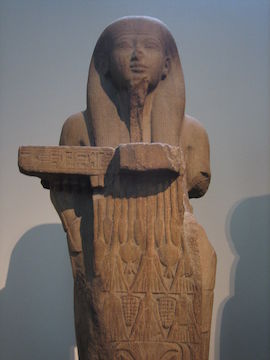
One of the oldest references to Hapi is in the Pyramid Texts of Unas. Hapi (here called Hep) is linked to the Nome of Kenset (including the First Cataract and the islands of Elephantine, Sahel, Philae, and others) and to (Wepwawet, the opener of the ways).
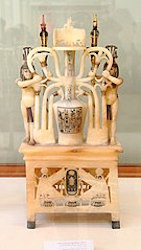
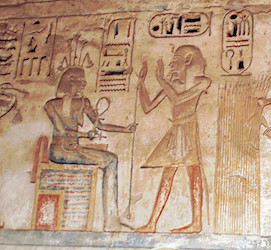
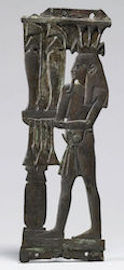
The texts implore Hapi and Wepwawet send a good inundation. According to myth, the river flowed from Hapi’s home (near the First Cataract) through the heavens and the land of the dead before emerging from a cave somewhere in the mountains. The inundation was referred to as the “Arrival of Hapi” and during the flood the Egyptians would place statues of the god in the towns and cities so that they could implore his assistance at that time. They would throw offerings into the river at places sacred to the god to ensure the inundation was not too low (leaving insufficient water for the crops) or too high (risking the destruction of their mud-brick homes).
The gods Khnum, Anuket, and Satet were the guardians of the source of the Nile who ensured that the correct amount of silt was left by the waters, but Hapi controlled the water itself. He was also associated with the Delta and given the epithet “Lord of the Fishes and Birds of the Marshes”.
As a god of water, he was often associated with Nun (the personification of the primeval waters of chaos in the Ogdoad theology from Heliopolis) and was described as the husband of Naunet (Nun’s wife and female aspect). Because the sun god (Ra or Atum) emerged from the waters of Nun on the first day of creation, Hapi was sometimes considered to be the father of the sun god and therefore the father of all life forms. It is probably because of these solar connections that Akhenaten did not reject hapi along with Amun and the majority of the other gods, instead describing him as an incarnation of The Aten.
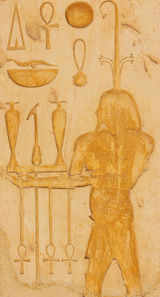
He was also associated with Osiris because of his link to the Nile and fertility. As a result, Isis was sometimes considered to be his female counterpart or his wife. The Pyramid Texts make it clear that many of the ancient goddesses (for example Mut) were linked with Hapi as aspects of Isis. He was also the husband of Nekhebet in Upper Egypt and Wadjet in Lower Egypt, both goddesses were at times associated with Isis.

Hapi was depicted as a plump man with large breasts and blue or green skin wearing the false beard of the pharaoh. The female breasts and his skin colour are a reminder that he is a fertility god, while the false beard reaffirms his link to the pharaoh. As the patron of Upper and Lower Egypt Hapi was often depicted as twin deities; Hap-Reset who wears the papyrus of Upper Egypt on his headdress and Hap-Meht who wears the lotus of Lower Egypt on his headdress. When he is depicted as a single god he often carries both the papyrus and lotus.
Bibliography
- Bard, Kathryn (2008)An introduction to the Archaeology of Ancient Egypt
- Goodenough, Simon (1997) Egyptian Mythology
- Pinch, Geraldine (2002) Handbook Egyptian Mythology
- Redford Donald B (2002) Ancient Gods Speak
- Watterson, Barbara (1996) Gods of Ancient Egypt
- Wilkinson, Richard H. (2003) The Complete Gods and Goddesses of Ancient Egypt
Copyright J Hill 2010